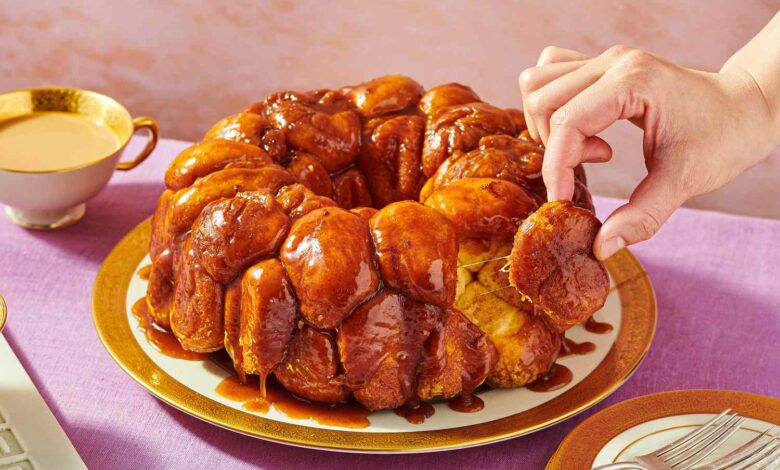This Homemade Monkey Bread Is Fluffy, Gooey, and Wonderfully Sweet

Why It Works
- Enriching the dough with milk, butter, and egg creates a tender, flavorful dough.
- Drizzling the syrup over the dough and tilting the pan from side to side evenly distributes the syrup, resulting in wonderfully gooey monkey bread.
There’s no such thing as too much cinnamon sugar: I’d happily eat all the cinnamon buns, cinnamon-sugar soft pretzels, and Moravian sugar cake I can get my hands on. Given my love for all things cinnamon, it’s no surprise that I also love monkey bread, a syrupy pull-apart pastry with plenty of cinnamon. The bread typically consists of dough that is rolled into balls, dipped in melted butter and cinnamon-sugar, then nestled in a Bundt pan and drenched in brown sugar syrup. As the loaf bakes, the syrup caramelizes and coats each roll. The pieces of dough cling together, creating a tear-and-share style loaf that is pillowy-soft, satisfyingly sticky, and downright delicious.
The loaf has a variety of names, including pinch me cake, bubble loaf, sticky bread, pull-apart cake, plucking cake, and monkey brains. But no matter what you call it, this cinnamon-y sweet treat is easy to make, fun to eat, and the ultimate dessert for sharing. No knives or utensils required, but you might want to keep the wet wipes handy.
Serious Eats/ Qi Ai
A Brief History of Monkey Bread
Monkey bread likely evolved from aranygaluska, a round pull-apart cake that Hungarian immigrants brought with them to America during the 19th century. Consisting of dough balls rolled in walnuts and sugar, the cake is not unlike monkey bread today. In 1950, Betty Crocker’s Picture Cookbook included a recipe inspired by the Eastern European baked good. Called a “Hungarian Coffee Cake,” the book’s version is made with yeast-raised dough that’s coated with melted butter, pecans, and cinnamon sugar. This pull-apart style of pastry soon earned the name “monkey bread,” possibly because its appearance resembled the South American monkey puzzle tree, or because it’s consumed by pulling the pieces apart by hand—the way monkeys eat.
Monkey bread recipes began appearing in American women’s magazines from the 1950s onward. The first lady Nancy Reagan further popularized the pastry by serving it at White House Christmas parties in the 1980s, and shared her recipe in both the 1987 White House Family Cookbook and the 1992 USO Celebrity Cookbook. ZaSu Pitts, a 1930s silent film star whose own recipe appeared in the Winnipeg Free Press in 1945, is often credited with introducing monkey bread to Reagan, who—like her husband—was an actor before her time in the White House.
Today, the pastry is sold in coffee shops and bakeries, and many home cooks create their own versions—often with canned or frozen buttermilk biscuits—at home. While there’s nothing wrong with reaching for ready-made dough when you’re in a pinch, taking the time to make monkey bread from scratch can result in an even more delicious and rewarding bake.
Serious Eats / Qi Ai
How to Make the Ultimate Monkey Bread
Make an enriched dough from scratch. Ready-made biscuit dough is, well, rather biscuit-like, not the soft, pillowy dough that’s ideal for something like monkey bread. Here, I create a yeasted dough enriched with eggs and butter, resulting in a moist, fluffy texture similar to that of milk bread or brioche. The fat from the eggs and butter coats the gluten proteins glutenin and gliadin, limiting the amount of gluten that can form. While gluten is essential for the structural integrity of the loaf, too much gluten can result in tough, chewy monkey bread. By incorporating plenty of dairy, we make it harder for the proteins to bond, while also giving the monkey bread its buttery flavor.
Portion your dough. I recommend rolling the dough into a rectangle, then slicing it into six rows of eight for 48 portions of dough. The portions don’t need to be perfectly precise, though, and you can eyeball it if you don’t feel like cutting the rectangle into squares. Portioning the dough gives the monkey bread its signature look and makes it easy to tear and share.
Coat the dough in butter and cinnamon sugar. To coat the dough, I dip each ball into melted butter, then drop it into a bowl of cinnamon sugar. The fat and moisture from the butter, however, can cause the cinnamon sugar to clump up. Rather than rolling the balls in the main bowl, I separate some of the coating into a smaller dish and use it for dipping, then top it off as needed, which prevents the cinnamon sugar from clumping. Don’t be stingy with the butter and sugar—try to use all or most of both. The sugar is important because it helps glue the dough into its pretty loaf shape, while the oil in the butter lubricates the dough so it doesn’t adhere too firmly—you want the pieces to pull apart with relative ease. There’s no need to create a specific pattern as you arrange the balls in the pan, since the freeform appearance is part of the charm.
Drizzle the monkey bread with a brown sugar syrup. The drizzle should look thick and syrupy, but don’t worry if the butter separates slightly or if the mixture doesn’t look totally smooth. (Do not boil or cook the syrup for an extended period, as this can cause the sugar to crystallize and result in a grainy syrup that’s difficult to pour.) To give the syrup its deep butterscotch flavor, I use brown sugar, which has deep molasses notes. I like to use light brown sugar, since that’s what I typically have in my pantry, but dark brown sugar is delicious too. After you drizzle the syrup all over the loaf, gently tilt the pan or tap it lightly on the countertop so the syrup can sink into the nooks and crannies between each ball and down the sides of the pan, thoroughly coating the entire loaf.
Let it cool. Though it’s tempting to invert the bread immediately after baking, it’s crucial to wait five minutes before flipping it out onto a rimmed serving plate. If you release it immediately, the syrup will create a sticky mess, and if you wait too long, the brown sugar will stick to the pan, making it difficult to remove and ruining the pretty topping. After inverting, allow the bread to cool for another 20 to 30 minutes, until it’s just warm but no longer piping hot. You’ll likely want to dive in straight away, but be patient, or you’ll burn your hands and tongue, which will make for a deeply unsatisfying monkey bread experience.
Serious Eats / Qi Ai
This Homemade Monkey Bread Is Fluffy, Gooey, and Wonderfully Sweet
Cook Mode
(Keep screen awake)
For the Dough:
-
Nonstick spray
-
240 ml (1 cup) whole milk, warmed to 100°F (38°C)
-
60 ml (1/4 cup) water, warmed to 100°F (38°C)
-
50 g granulated sugar (1 3/4 ounces; 1/4 cup)
-
7 g (2 1/4 teaspoons) active dry yeast
-
42 g unsalted butter (1 1/2 ounces; 3 tablespoons), melted
-
7 g (1 1/2 teaspoons) Diamond Crystal kosher salt; for table salt, use half as much by volume
-
1 large egg, at room temperature or the same weight
-
545 g all-purpose flour (19 1/4 ounces; 4 1/4 cups)
To Assemble:
-
265 g granulated sugar (9 1/3 ounces; 1 1/3 cups)
-
6 g (2 1/2 teaspoons) ground cinnamon
-
113 g unsalted butter (4 ounces; 8 tablespoons), melted
For the Brown Sugar Drizzle:
-
113 g unsalted butter (4 ounces; 8 tablespoons)
-
150 g light brown sugar (5 1/4 ounces; about 3/4 cup)
-
For the Dough: Using nonstick spray, generously grease a large mixing bowl and a 12-cup Bundt pan.
Serious Eats / Qi Ai
-
In the bowl of a stand mixer fitted with the dough hook attachment or in a traditional bowl if kneading by hand, whisk milk, water, granulated sugar, and yeast to combine. Let sit until foamy, 4 to 5 minutes.
Serious Eats / Qi Ai
-
Add melted butter, salt, egg, and half of the flour. See notes if kneading by hand. If using a stand mixer, add remaining flour and mix on low speed until no dry spots remain, 30 to 60 seconds. Increase speed to medium and mix, pausing to scrape down bottom and sides of the bowl with a flexible spatula or dough scraper as needed, until dough is elastic but still slightly sticky, 6 to 8 minutes.
Serious Eats / Qi Ai
-
Using a dough scraper, scrape dough into greased bowl. Cover with greased plastic wrap and let sit at warm room temperature (75 to 80°F; 24 to 27°C) until doubled in size, 1 to 1 1/2 hours.
Serious Eats / Qi Ai
-
To Assemble: In a small bowl, whisk granulated sugar and ground cinnamon to combine.
Serious Eats / Qi Ai
-
Punch dough down. Tip dough onto unfloured countertop and pat into a rectangle approximately 14 by 8 inches in size. Using a sharp greased chef’s knife, cut 6 strips of dough lengthwise and 8 strips of dough crosswise to create 48 portions of dough; each should weigh about 20 g (about 3/4 ounces). (See notes.)
Serious Eats / Qi Ai
-
Working with one portion of dough at a time, shape by cupping the dough portion in your hand and rolling it in a circular motion until a tight ball forms. Dip each ball in melted butter and toss with cinnamon sugar to evenly coat. Because the butter can cause the cinnamon sugar to clump. I recommend scooping some of the cinnamon sugar into a separate bowl and using that—rather than the primary bowl—for rolling, and adding more cinnamon sugar as needed. Place ball in prepared Bundt pan. Repeat with remaining dough.
Serious Eats / Qi Ai
-
Stretch greased plastic wrap across top of Bundt pan, cover, and let rise at warm room temperature (75 to 80°F; 24 to 27°C) until puffy and dough reaches top of the pan, 45 minutes to 1 hour.
-
Adjust oven rack to middle position and preheat oven to 350°F (175°C). When positioning the oven rack, make sure there isn’t another rack directly above your loaf pan, or the bread will wrap itself around the rack as it bakes.
-
For the Brown Sugar Drizzle: In a medium saucepan, melt butter over medium-low heat. Add brown sugar, whisking until fully dissolved and mixture resembles a thick syrup. (Do not boil.) Pour over monkey bread, distributing drizzle evenly across surface of dough. Tilt pan from side to side and tap gently on countertop, allowing syrup to sink down sides of pan and into cracks and open spots.
Serious Eats/ Qi Ai
-
Bake until dough has risen 1/2 to 1 inch above pan, is deeply golden brown, and registers 200°F (93°) on an instant-read thermometer, 40 to 50 minutes. Let stand until just cool enough to touch, about 5 minutes. Top Bundt pan with a rimmed serving plate, then, using gloved hands or two kitchen towels, flip pan to carefully invert monkey bread onto plate. Using a serving spoon or rolling pin, gently tap top of pan to release loaf, scraping any additional syrup onto the bread. Let sit until just warm, 20 to 30 minutes. Serve warm.
Serious Eats/ Qi Ai
Optional Decorative Glaze
In a small bowl, whisk 50 g (1 3/4 ounces; 1/2 cup) confectioners’ sugar, 2 to 3 teaspoons whole milk, and 1/2 teaspoon vanilla extract until smooth. Pipe or drizzle over cooled loaf.
Special Equipment
12-cup Bundt pan, stand mixer, bench scraper, whisk, rimmed serving plate
Notes
To knead dough by hand: After whisking together melted butter, salt, and half of the flour, use a bench scraper to work in remaining flour until a sticky, lumpy dough forms. Turn out onto lightly floured countertop. Knead 8 to 10 minutes, or until dough is smooth, elastic, and just slightly sticky, 8 to 10 minutes.
Cutting the dough into squares ensures the correct number of balls and keeps them roughly the same size. Each strip should be roughly 1 1/2 inches wide, but don’t worry about being perfectly precise—some variation in size is fine.
Make-Ahead and Storage
Monkey bread tastes best on the day it is made. Leftover monkey bread can be stored in an airtight container or wrapped tightly in plastic wrap and kept at room temperature for up to 1 day.





